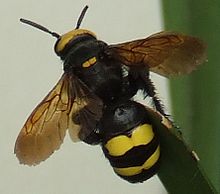Mammoth wasp
| Mammoth wasp | |
|---|---|

| |
| Megascolia maculata flavifrons | |
| Scientific classification | |
| Domain: | Eukaryota |
| Kingdom: | Animalia |
| Phylum: | Arthropoda |
| Class: | Insecta |
| Order: | Hymenoptera |
| Family: | Scoliidae |
| Genus: | Megascolia |
| Species: | M. maculata
|
| Binomial name | |
| Megascolia maculata (Drury, 1773)
| |
| Subspecies[1] | |
| |
| Synonyms[1] | |
| |
The mammoth wasp (Megascolia maculata) is a species of wasp belonging to the family Scoliidae in the order Hymenoptera. It is a parasitoid on scarab beetles and is found in Europe and Asia and is the largest wasp found in Europe.
Description
[edit]The mammoth wasp resembles a very large, elongated bumble bee. The female is larger than the male and has a yellow head, the male has a black head. Its body is covered in downy hair and is glossy black in colour with two yellow bands across its abdomen which are sometimes divided to form four yellow spots.[2] Females have shorter antennae than males.[3] The females may reach a length of 4.5 cm (1.8 in) and the males are smaller than the females.[4]
Distribution
[edit]The mammoth wasp occurs in southern Europe as far north as the Czech Republic, where it was first recorded in 2013,[5] into Russia,[6] North Africa and the near east.[5] It has been recorded in southern Great Britain but as its prey does not occur in Britain it will be unable to establish there.[7]
Habitat
[edit]The mammoth wasp is found in Mediterranean type habitats such as oak forests, maquis and garrigue. It can only occur where its prey, the European rhinoceros beetle Oryctes nasicornis, is found too and in Russia it has been noted that it is commonest around human habitation where manure piles, sawmills and compost heaps provide habitat for its prey.[citation needed]
Biology
[edit]The adult mammoth wasps feed on nectar from flowers. In Malta they have been associated with wild artichoke and Carpobrotus edulis.[8] The female hunts in dead wood for the grubs of the European rhinoceros beetle which it paralyses by stinging it and then lays a single egg on the larva. The larval wasp consumes the beetle larva apart from its skin. Once the beetle larva had been consumed the wasp larva builds a cocoon and pupates, emerging from the cocoon as an adult in the following spring.[4] The European rhinoceros beetle is the primary host for the mammoth wasp but it will also lay eggs on the larvae of other beetles in the Scarabaeoidea including Polyphylla fullo, Anoxia orientalis, the European or greater stag beetle (Lucanus cervus) and Pentodon idiota.[9]
In culture
[edit]
It is suggested as the insect model used for the gold "Malia Pendant", a jewel of high quality gold-smithery of the Minoan times.[10]
Gallery
[edit]-
Larval Megascolia maculata feeding on an Oryctes nasicornis larva
-
M. maculata bischoffi, an endemic subspecies to Cyprus.
-
M. maculata flavifrons, which has black setae on the abdomen.
-
M. maculata flavifrons with red setae on the abdomen.
-
M. maculata flavifrons with yellow setae on the abdomen.
References
[edit]- ^ a b "Megascolia maculata". Global Biodiversity Information Facility. Retrieved 2024-10-23.
- ^ "Notes on a Spanish Valley A Mammoth Wasp". Wordpress.com. 19 August 2016. Retrieved 21 May 2017.
- ^ "MAMMOTH WASP (MEGASCOLIA (REGISCOLIA) MACULATA FLAVIFRONS) AVISPA PARASITA DE CUATRO PUNTAS". Wildside Holidays. 26 February 2021. Retrieved 28 July 2023.
- ^ a b "Mammoth Wasp". Nightingale Trails. 19 February 2011. Retrieved 21 May 2017.
- ^ a b Piotr Olszewski; Bogdan Wiśniowski; Pter Bogusch; Tadeusz Pawlikowski (2016). "Distributional History and Present Status of the Species of the Family Scoliidae (Hymenoptera) in Poland and the Czech Republic" (PDF). Acta Zoologica Bulgarica. 68 (1): 43–54.
- ^ Emets, Viktor (2019). "Оn the penetration and settlement of the mammoth wasp (Megascolia maculata) in the territory of the Biosphere Nature Reservation "Voronezhsky" (Central Russia)". Euroasian Entomological Journal. 18: 91–98. doi:10.15298/euroasentj.18.2.03.
- ^ "Can anyone identify this large black wasp?". Natural History Museum. Retrieved 21 May 2017.
- ^ Paul Portelli (2013). "The mammoth wasp". Times of Malta. Retrieved 21 May 2017.
- ^ "Mammoth Wasp (Megascolia maculata)". life4oakforests.eu. Retrieved 28 July 2023.
- ^ Nelson, E Charles; Mavrofridis, Georgios; Anagnostopoulos, Ioannis Th (2021). "Natural History of a Bronze Age Jewel Found in Crete: The Malia Pendant". The Antiquaries Journal. 101: 67–78. doi:10.1017/S0003581520000475. S2CID 224985281.





